Kentucky Coffee Tree (Gymnocladus Dioicus): Pods, Bark, Leaves, Identification and Care (Pictures)

The Kentucky coffee tree (also spelled coffeetree) is an attractive medium-sized deciduous tree with pinnate green leaves, greenish-white flowers, and large reddish-brown seed pods. Native to the Midwest, the Kentucky coffee tree is identified by its irregular oval crown with open branches that provide partial shade. Additionally, scaly gray-brown furrowed bark and reddish-brown twigs help identify the tree in winter.
The Kentucky coffee tree is a popular ornamental tree, thanks to its appearance and growth habit. The moderately fast-growing tree has attractive green leaves that turn bright yellow in the fall. The golden-yellow foliage contrasts nicely with the blackish-brown large seed pods dangling from the branches. In the winter, the Kentucky coffee tree has an attractive silhouette due to its open branching habit.
This article is a complete guide to identifying the Kentucky coffee tree. Descriptions and pictures of the coffeetree leaves, bark, flowers, and seed pods will help you recognize this ornamental native tree in all seasons.
About Kentucky Coffee Tree (Gymnocladus Dioicus)
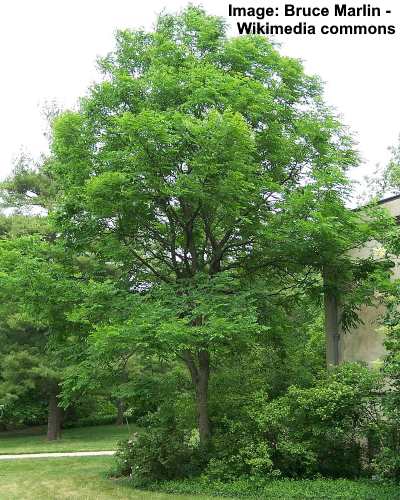
Kentucky coffee tree (Gymnocladus Dioicus)
The Kentucky coffee tree is the only native tree in the genus Gymnocladus in the legume family Fabaceae. The attractive deciduous tree with its open, irregular crown grows between 60 and 70 ft. (18 – 21 m) and 40 to 50 ft. (12 – 15 m) wide.
The Kentucky coffee tree is a handsome shade tree with a distinctive appearance in the landscape. The coffeetree has unusual bark, short contorted twigs, white star-shaped flowers, and characteristic brownish-black seed pods.
The Kentucky coffee tree got its name from the coffee-like beverage you can brew from the roasted seeds. The botanical name gymnocladus means “naked branch,” referring to its conspicuous stout twigs. Other names for this ornamental tree include American mahogany, American coffee berry, chicot tree, and nettle tree. Because the tree’s growth is dormant for six months, it has also earned the name stump tree or dead tree.
Part of its botanical name “dioicus,” means there are male and female trees. Male Kentucky coffee trees have small white star-shaped flowers growing in clusters measuring 4” (10 cm) long. Female tree flowers are larger. The greenish-white female tree flower clusters can measure 8” to 12” (20 – 30 cm) long.
Male trees tend to cause less mess as they don’t produce seed pods, making them suitable for planting in a residential landscape. Additionally, the Kentucky coffee tree is tolerant of drought and urban air pollution.
Despite its common name, the Kentucky coffee tree isn’t related to the coffee plant (Coffea). However, you can make a coffee-like drink by roasting the tree seeds or beans. The roasted seeds are a good substitute for coffee with a similar taste to chicory. Roasting the beans is also vital to remove the toxins that the pods and beans contain.
The Kentucky coffee tree has use in the timber industry. Its strong wood is relatively rot-resistant, making it ideal for fence posts, general construction, railway sleepers, or sills. In addition, the wood is easy to work with and is a popular choice for making fine furniture.
Kentucky Coffee Tree Pods
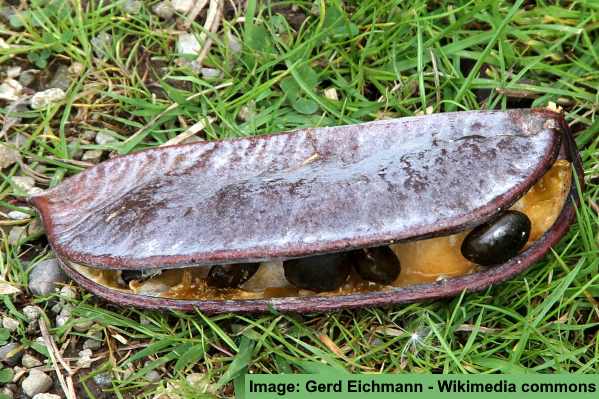
Kentucky coffee tree pod
Large pods or fruit on the Kentucky coffee tree appear green and turn reddish-brown throughout the winter. The flattened seed pods are thick and leathery and measure 5” to 10” (12 – 25 cm) long and up to 2” (5 cm) wide. The coffee tree pods ripen in October and persist until early spring, when they drop.

A mature pod on Kentucky coffee tree
One of the features of Kentucky coffee tree pods is the rattling sound they make in the wind. The clattering noise occurs as the hard seed-filled brown bean-like pods knock together.
Litter can be an issue with Kentucky coffee trees when the pods fall to the ground. The pods contain seeds in a sticky pulp that can make a mess on hard surfaces.
It’s good to remember that the pods and the seeds are poisonous.
Kentucky Coffee Tree Seeds
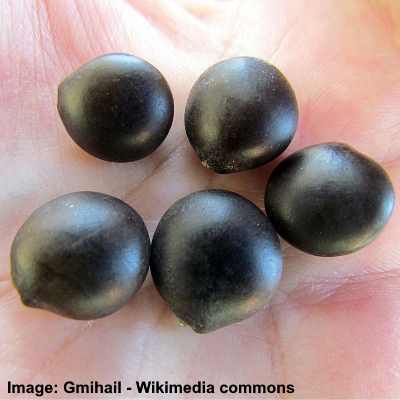
Kentucky coffee tree seeds
Kentucky coffee tree seeds can be olive-green or dark-brown, almost black. There are three to nine seeds in a pod, each measuring 0.6” to 0.75” (1.5 – 2 cm) long. A gel-like substance surrounds the round, dark-colored seeds. But they have a hard outer shell, making them difficult to germinate.
Like the pods, Kentucky coffee tree seeds are highly toxic. Therefore, the raw seeds must be well-roasted to remove the toxins. Once roasted, there is a resemblance of the seeds to coffee beans. You can grind the seeds and brew them as you would coffee beans to make a caffeine-free drink.
The seeds and pods also look like the sweet fruit of the honey locust tree. So, you should be careful if you are picking the non-toxic honey locust fruit. Ingesting raw Kentucky coffee tree seeds can result in nausea, stomach pain, vomiting, and diarrhea.
Kentucky Coffee Tree Bark
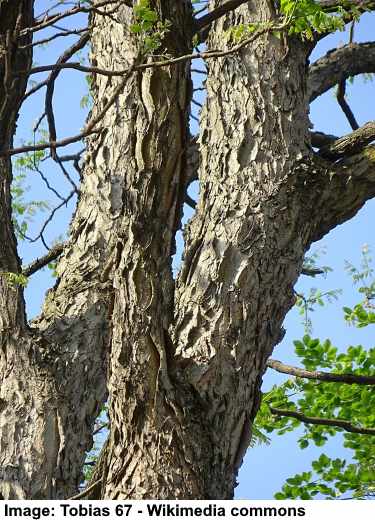
Kentucky coffee tree bark
Kentucky coffee tree bark is characteristically rough, with a scaly surface and deep fissures running up the trunk, forming zig-zag patterns. The coffee tree bark has an identifiable tan or ash-gray color and flakes like a black cherry tree. You’ll notice that the ends of the scaly plates curl.
Another attractive feature of the Kentucky coffee tree is the color of its winter twigs. The stout bare twigs have a dark reddish-brown or greenish-brown color. The thin bark covering the twigs peels to reveal a light pinkish pith. The lateral buds on the branches are bronze-colored, and there is no terminal bud.
Kentucky Coffee Tree Leaves

Kentucky coffee tree leaves
Kentucky coffee trees have identifiable pinnately compound leaves consisting of five to nine pairs of almond-shaped leaflets measuring around 2” (5 cm) long growing alternately on reddish branches. The feathery dark green leaves can be between 1 and 3 ft. (0.3 – 1 m) long. The coffee tree leaves appear in spring and turn bright golden yellow in the fall.
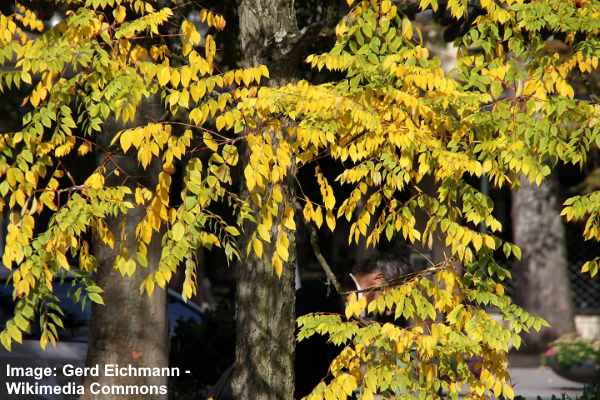
Kentucky coffee tree leaves in autumn
Kentucky Coffee Tree Flowers
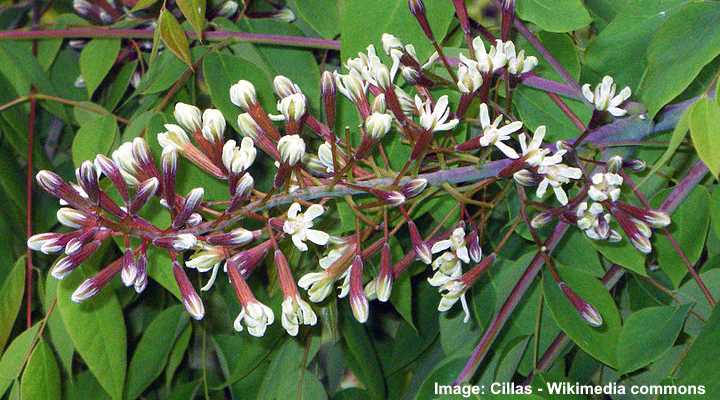
Kentucky coffee tree flowers
Kentucky coffee tree flowers are star-shaped and greenish-white in color, measuring around 1” (2.5 cm), and they blossom in May and June. The large panicles (clusters) consist of flowers, each in the shape of a star. Male and female Kentucky coffee trees produce flowers.
Male flowers on Kentucky coffee trees are clusters of small greenish-white flowers, with each panicle measuring 3” to 4” (7.5 – 10 cm) long.
Kentucky coffee female tree flowers are more prominent and measure 8” to 12” (20 – 30 cm) long. Fertilized female coffee trees produce large 10” (25 cm) dark leathery seedpods with up to eight seeds. Unfertilized female trees produce small, seedless pods.
Kentucky Coffee Tree Growth Rate
The Kentucky coffee tree is a moderately fast-growing tree when it’s immature and can grow 12” to 24” (30 – 60 cm) per year. The ornamental landscape tree grows around 13 ft. (4 m) in the first ten years. After that, the tree’s growth slows somewhat. Therefore, mature Kentucky coffee trees are typically classified as trees with a slow to moderate growth rate.
Kentucky Coffee Tree Identification
A Kentucky coffee tree is identified by distinctive rough, scaly gray bark, large dark green pinnately compound leaves, and greenish-white clusters of late spring flowers. However, the most identifiable feature of the coffee tree is the large, leathery dark seed pods that dangle from the reddish branches from fall throughout winter.
Kentucky Coffee Tree Hardiness Zone
Kentucky coffee trees are relatively hardy deciduous trees that thrive in USDA zones 3 through 8. The coffeetree performs well in full sun and fertile, well-drained soils. This tough native tree tolerates spells of drought and can also withstand occasional flooding and urban conditions.
Kentucky Coffee Tree Habitat
The Kentucky coffee tree’s natural habitat is in the Midwest and the central United States; however, the tree transplants easily and grows in a wide range of habitats. You can find the coffee tree growing in floodplains, along riverbanks, or in beautiful rich woodlands. Because the Kentucky coffee tree is intolerant of shade, it usually grows on the edges of moist woods.
The leafy landscape Kentucky coffee tree performs just as well in compacted clay soil as in sandy, loamy soil.
Sometimes the Kentucky coffee tree can appear dead in landscapes. This is because the tree is leafless from late fall until late spring. However, the attractive branching of the medium-sized tree creates plenty of visual appeal, despite the lack of foliage.
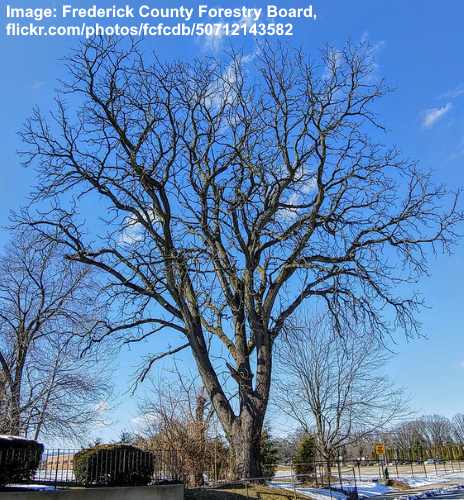
Kentucky coffee tree in winter
Where to Grow Kentucky Coffee Tree in a Garden Landscape
The Kentucky coffee tree has plenty of uses in residential landscapes. The tree’s open branching habit and large feathery leaves provide plenty of shade in the summer. However, the coffee tree’s canopy isn’t so dense that it blocks sunlight from shrubs, lawns, or flowering plants.
The toughness of the Kentucky coffee tree and its robustness make it a choice tree species for more commercial landscapes. The grayish tree with its distinctive peeling bark and ascending branches grows well as a street tree, in parks, or along the edges of woodlands surrounding golf courses.
In landscapes, the Kentucky coffee tree resembles the locust tree. Also, male cultivars are usually the ideal choice for growing as there is no mess from the sticky pulp contained in the seedpods. Additionally, Kentucky coffee trees don’t require any pruning.
How to Plant a Kentucky Coffee Tree
The Kentucky coffee tree is an easy-to-grow landscape tree that tolerates extreme weather conditions. You can plant the tree in cold regions like USDA zones 3 and 4. And it will thrive in temperate climates up to zone 8.
When planting the Kentucky coffee tree in the landscape, choose a sunny location that has well-drained ground. The hardy coffee trees adapt well to most soils—fertile, compacted, loamy, moist, dry, or alkaline soils. It’s also good to remember to give the tree enough room as it can spread up to 50 ft. (15 m).
How to Grow a Kentucky Coffee Tree From Seed
Kentucky coffee tree seeds are extremely hard and need preparation to grow from seed. The dark brown coffee seeds rarely germinate in the wild. To grow a coffee tree from seed, you need to scarify the seeds to soften them.
To prepare the rock-hard seeds for germination, put the bean-like seed in a non-metallic, heat-proof bowl. Pour plenty of boiling water over the seeds and stir with a spoon. Leave overnight to soak. Then remove any floating seeds.
Alternatively, you can file or sand the black hard seed coat until you reveal the yellow inner seed. This process allows water to penetrate the seeds when in moist potting soil.
To plant the softened or scarified Kentucky coffee tree seeds, put the seeds in a pot containing equal amounts of moist peat moss and perlite. The seeds should be 1” to 2” apart (2.5 – 5 cm) in the potting mix. Then water thoroughly. Place the pot in partial sunlight and keep the soil moist. The seedlings should appear in two to four weeks.
You can grow the young Kentucky coffee tree in a one-gallon (3.7 l) container until ready to transplant to your garden.
Kentucky Coffeetree ‘Kentucky Espresso’
The Kentucky coffee tree ‘Espresso’ is a male, seedless cultivar with graceful, arching branches, white fragrant flowers, large compound dark green leaves, and spectacular yellow fall color. The ‘Espresso’ Kentucky coffee tree grows up to 75 ft. (22 m) tall and 50 ft. (15 m) wide. The deciduous tree grows in a wide range of soils in full sun.
Kentucky Coffee Tree ‘Stately Manor’
The Kentucky coffee tree ‘Stately Manor’ is a fruitless cultivar with an upward, narrow branching habit and elm-like vase shape. The medium-size landscape tree grows up to 50 ft. (15 m) tall and 30 ft. (9 m) wide. The ‘Stately Manor’ coffee tree features bipinnately compound leaves and has identifiable dark brown bark.
Kentucky Coffee Tree ‘Prairie Titan’
The Kentucky coffee tree ‘Prairie Titan’ is a medium-sized landscape tree that doesn’t produce seed pods. The upright spreading tree grows between 60 and 68 ft. (18 – 21 m) tall. The ‘Prairie Titan’ Kentucky coffee tree has blue-green foliage, clusters of insignificant white flowers, and attractive peeling bark.
Related articles:
- Zelkova Trees: Types and Identification
- Tabebuia Tree: Types and Identification
- Orchid Tree (Bauhinia): Types and Identification
